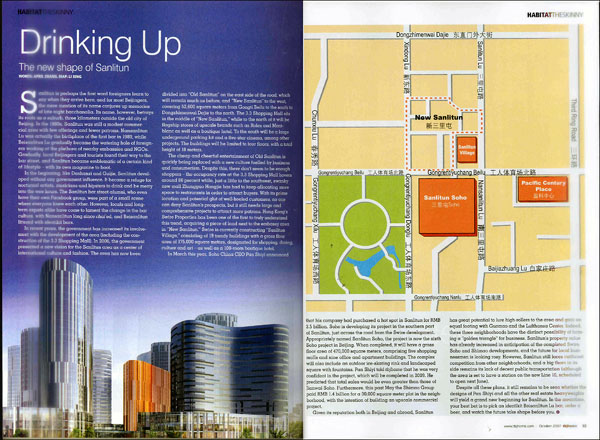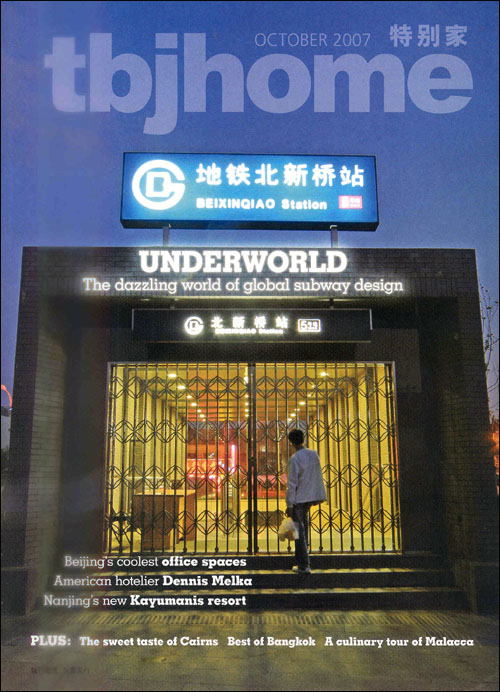
News & Media
tbjhome - Drinking up

The new shape of Sanlitun
Sanlitun is perhaps the first word foreigners learn to say when they arrive here, and for most Beijingers, the mere mention of its name conjures up memories of late night bacchanalia. Its name, however, betrays its roots as a suburb, three kilometers outside the old city of Beijing. In the 1980s, Sanlitun was still a modest commercial area with few offerings and fewer patrons. Nansanlitun Lu was actually the birthplace of the first bar in 1989, while Beisanlitun Lu gradually became the watering hole of foreigners working at the plethora of nearby embassies and NGOs. Gradually, local Beijingers and tourists found their way to the bar street, and Sanlitun became emblematic of a certain kind of lifestyle-with its own magazine to boot.
In the beginning, like Dashanzi and Guijie, Sanlitun developed without any government influence. It became a refuge for nocturnal artists, musicians and hipsters to drink and be merry into the wee hours. The Sanlitun bar street alumni, who even have their own Facebook group, were part of a small scene where everyone knew each other. However, locals and longterm expats alike have come to lament the change in the bar culture, with Nansanlitun long since chai’ed, and Beisanlitun littered with identikit bars.
In recent years, the government has increased its involvement with the development of the area(including the construction of the 3.3 Shopping Mall). In 2006, the government presented a new vision for the Sanlitun area as a center of international culture and fashion. The area has now been divided into "Old Sanlitun" on the east side of the road, which will remain much as before, and "New Sanlitun" to the west, covering 52,600 square meters from Gongti Beilu to the south to Dongzhimenwai Dajie to the north. The 3.3 shopping Mall sits in the middle of "New Sanlitun," while to the north of it will be flagship stores of upscale brands such as Rolex and Montblanc as well as a boutique hotel. To the south will be a large underground parking lot and a five-star cinema, among other projects. The buildings will be limited to four floors, with a total height of 18 meters.
The cheap and cheerful entertainment of Old Sanlitun is quickly being replaced with a new culture fuelled by business and consumerism. Despite this, there don´t seem to be enough shoppers-the occupancy rate at the 3.3 shopping Mall hovers around 86 percent while, just a little to the southwest, swanky new mall Zhongguo Hongjie has had to keep allocating more space to restaurants in order to attract buyers. With its prime location and potential glut of well-heeled customers, no one can deny Sanlitun´s prospects, but it still needs large and comprehensive projects to attract more patrons. Hong Kong´s Swire Properties has been one of the first to truly understand this trend, acquiring a piece of land next to the embassy area in "New Sanlitun" Swire is currently constructing "Sanlitun Village," consisting of 19 trendy buildings with a gross floor area of 175,000 square meters, designated for shopping, dining, culture and art-as well as a 100-room boutique hotel.
In March this year, SOHO China CEO Pan Shiyi announced that his company had purchased a hot spot in Sanlitun for RMB 3.5 billion. SOHO is developing its project in the southern part of Sanlitun, just across the road from the Swire development. Appropriately named Sanlitun SOHO, the project is now the sixth SOHO project in Beijing. When completed, it will have a gross floor area of 470,000 square meters, comprising five shopping malls and nine office and apartment buildings. The complex will also include an outdoor ice-skating rink and landscaped square with fountains. Pan Shiyi told tbjhome that he was very confident in the project, which will be completed in 2009. He predicted that total sales would be even greater than those of Jianwai SOHO. Furthermore, this past May the Shimao Group paid RMB 1.4 billion for a 30,000 square meter plot in the neighborhood, with the intention of building an upscale commercial project.
Given its reputation both in Beijing and abroad, Sanlitun has great potential to lure high-rollers to the area and gain an equal footing with Guomao and the Lufthansa Center. Indeed, these three neighborhoods have the distinct possibility of forming a "golden triangle" for business. Sanlitun´s property value has already increased in anticipation of the completed Swire, SOHO and Shimao developments, and the future for local businessmen is looking rosy. However, Sanlitun still faces cutthroat competition from other neighborhoods, and a big thorn in its side remains its lack of decent public transportation(although the area is set to have a station on the new Line 10, scheduled to open next June).
Despite all these plans, it still remains to be seen whether the designs of Pan Shi yi and all the other real estate heavyweights will yield a grand new beginning for Sanlitun. In the meantime, your best bet is to pick an identikit Beisanlitun Lu bar, order a beer, and watch the future take shape before you.
